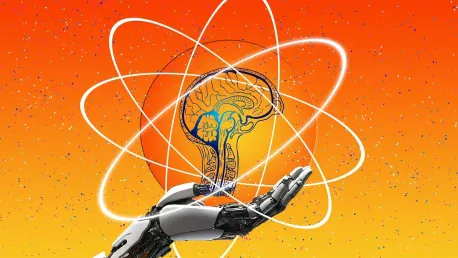Advancing Future Tech: Quantum Machine Learning Integration Unveiled
Quantum Machine Learning (QML) is at the crossroads of the latest advancements in quantum computing and artificial intelligence (AI). The merging of these two transformational technologies is sparking innovation across a spectrum of scientific and industrial sectors. With QML, we are witnessing a new era where the boundaries between classical and quantum data blur, fostering breakthroughs that challenge the conventional limits of data processing and problem-solving. Machine learning’s methodology—understanding patterns, gaining insights, and making predictions from data—gets a quantum boost, offering unprecedented computational power and efficiency.
This article delves into the symbiotic relationship between machine learning (ML) and quantum computing, expounding on their confluence and the emerging role of QML in shaping the future of technology.
The Dawn of Quantum Machine Learning
The Quantum-Classical Distinction
The key to understanding QML lies in distinguishing between classical and quantum data. Classical data is binary, represented by bits (0 or 1), and is prevalent in images, text, and other traditional datasets. In contrast, quantum data, using qubits, operates in a probabilistic manner, encapsulating complex states such as |0>, |1>, and their superpositions. This fundamental difference is the cornerstone upon which QML builds its formidable potential.
Quantum data extends into applications in quantum sensing, metrology, and quantum networks. These domains leverage the unique properties of qubits to achieve precision and efficiency unattainable by classical methods. Understanding these distinctions sets the stage for appreciating how QML amalgamates these worlds. By blending classical and quantum paradigms, researchers can develop algorithms that not only manage more complex datasets but also solve problems more efficiently.
Four Scenarios of Quantum Machine Learning
Classical-Classical (C-C) QML Applications
In the first scenario, classical machine learning techniques are applied to classical data, but with inspiration drawn from quantum information research. For instance, neural networks trained using tensor networks aid in understanding complicated quantum many-body phenomena. This crossover showcases how classical and quantum paradigms can mutually benefit from each other. Traditional ML models can simulate quantum problems, effectively utilizing classical hardware to derive insights about quantum systems, illustrating a beneficial interplay between the old and new computing paradigms.
This method is particularly relevant given the current limitations of quantum hardware, providing a bridge until quantum devices become more advanced. Using classical resources to simulate quantum problems enables researchers to make progress in understanding and leveraging quantum phenomena without needing fully operational quantum computers. This scenario demonstrates how classical ML remains indispensable even as quantum technology advances, offering a synergistic approach to harnessing the best of both worlds.
Classical-Quantum (C-Q) Crossroads
Classical-Quantum integration involves using quantum computing techniques to analyze classical datasets. This scenario exemplifies how quantum computers can process conventional data inputs, such as images and text, far more efficiently than classical systems. For instance, quantum state classification methods have demonstrated the potential to outpace conventional data mining methods. Converting classical data into quantum states allows quantum algorithms to address the data’s underlying properties more effectively, hinting at future possibilities where quantum computing significantly enhances data processing capabilities.
An example is the application of quantum algorithms to handwritten digit classification. By converting classical data into quantum states, these algorithmic approaches address the data’s underlying properties more efficiently, showcasing quantum computers’ prowess in handling classical data. Such advancements indicate a future where quantum computing can revolutionize fields reliant on extensive data mining and analysis, making it an invaluable tool for industries ranging from finance to healthcare.
The Intersection of Quantum and Machine Learning
Quantum-Classical (Q-C) Data Analysis
The third intersection, Quantum-Classical, applies machine learning to quantum data. This scenario highlights how ML algorithms can reveal insights from quantum measurement data, helping decipher various quantum manipulations and states. Machine learning thus serves as an essential tool for interpreting the complex data produced by quantum computing devices. ML techniques can analyze quantum data to improve the understanding of quantum systems, potentially leading to innovations in quantum technology applications.
For instance, researchers have used ML to infer the state of quantum systems from limited measurements, significantly improving the understanding of quantum device conditions. This application underscores the crucial role of classical ML algorithms in the quantum realm, enhancing the reliability and functionality of quantum hardware. It also underscores the potential for further advancements as researchers continue to refine these techniques, paving the way for more sophisticated quantum technology applications in the future.
Quantum-Quantum (Q-Q) Synergy
The fourth scenario, Quantum-Quantum, focuses on how quantum computers process quantum data, using quantum systems to feed QML algorithms. This involves quantum simulation, where one quantum system models another, providing deep insights into quantum phenomena. Q-Q scenarios utilize quantum systems’ full capabilities to simulate and analyze quantum data comprehensively. This area holds the promise of revolutionizing areas like drug discovery and materials science by providing profound computational efficiencies and new discovery pathways.
Quantum simulations can provide highly accurate models of complex quantum systems, enabling researchers to explore new theories and applications that were previously infeasible. This synergy between quantum systems opens up unprecedented avenues for scientific exploration and technological innovation, harnessing the full potential of QML to drive progress in various cutting-edge fields. Such innovations could lead to breakthroughs that significantly impact numerous industries, making quantum technology a cornerstone of future scientific and technological advancements.
The Evolution and Impact of Quantum Machine Learning
Software Libraries and Practical Applications
Advancements in software libraries like PennyLane, TensorFlow Quantum, and Yao have transformed theoretical QML into practical applications. These libraries offer simulators and cloud access to quantum hardware, fostering real-device testing and rapid application of QML models. These resources are enabling breakthroughs by offering researchers and developers the tools to implement and test QML algorithms effectively. The resulting acceleration in both theoretical and applied research highlights the powerful synergy between ML and quantum computing, driving innovation at an unprecedented pace.
The availability of such sophisticated tools has democratized access to quantum technology, allowing a broader range of researchers and developers to contribute to this burgeoning field. This democratization accelerates innovation and helps build a robust foundation for future advancements in QML, ensuring that the technology continues to evolve and expand its potential applications. As more individuals and organizations gain access to these tools, the collaborative nature of quantum research is likely to propel the field to new heights, fostering a vibrant ecosystem of innovation.
QML’s Trajectory and Key Developments
Recent research has shown that quantum versions of ML algorithms sometimes outperform classical ones, especially on smaller datasets and specific tasks. This shift marks a significant stride towards broader, more scalable QML applications, indicating that quantum computing’s practical advantages are beginning to manifest. Developments in variational circuits and machine learning models derived from these quantum circuits are critical to this progress. The continuous improvement in these areas is a testament to the collaborative progress driving QML forward, underlining its potential to consistently surpass classical ML.
The advancing sophistication of variational circuits, combined with ongoing enhancements in quantum hardware, suggests a future where QML applications could become commonplace across scientific and industrial domains. As the technology matures, we can expect to see an increasing number of real-world applications where QML provides a decisive edge, further solidifying its role as a transformative force in the tech landscape. The ongoing research and development efforts in this field underscore the tremendous potential of QML, promising a future where quantum and classical computing coexist and complement each other.
Pioneering Research and Foundational Texts
In the first scenario, classical machine learning (ML) techniques are leveraged on classical data, drawing inspiration from quantum information research. For example, neural networks that are trained using tensor networks can help us understand complex quantum many-body phenomena. This blending demonstrates the mutual benefits between classical and quantum paradigms. Traditional ML models simulate quantum problems using classical hardware, deriving insights about quantum systems and illustrating a beneficial interplay between old and new computing paradigms.
This method is especially pertinent given the current limitations of quantum hardware, providing a crucial bridge until quantum devices become more advanced. Simulating quantum problems with classical resources allows researchers to advance in understanding quantum phenomena without fully operational quantum computers. This scenario underscores the indispensability of classical ML, even as quantum technology evolves. It offers a synergistic approach to harnessing the strengths of both classical and quantum worlds, ensuring continuous progress in the field until more sophisticated quantum hardware becomes available.









